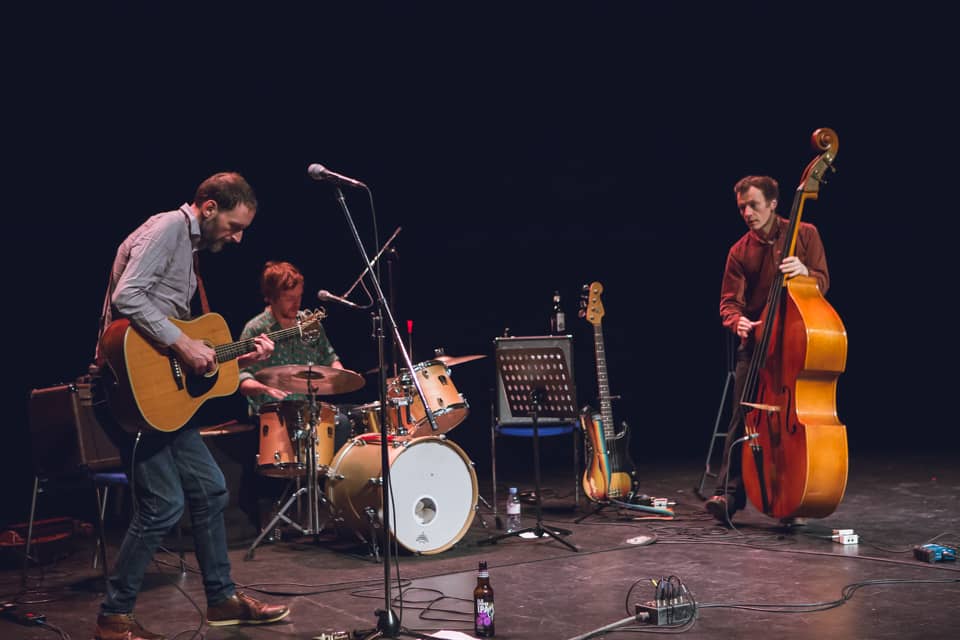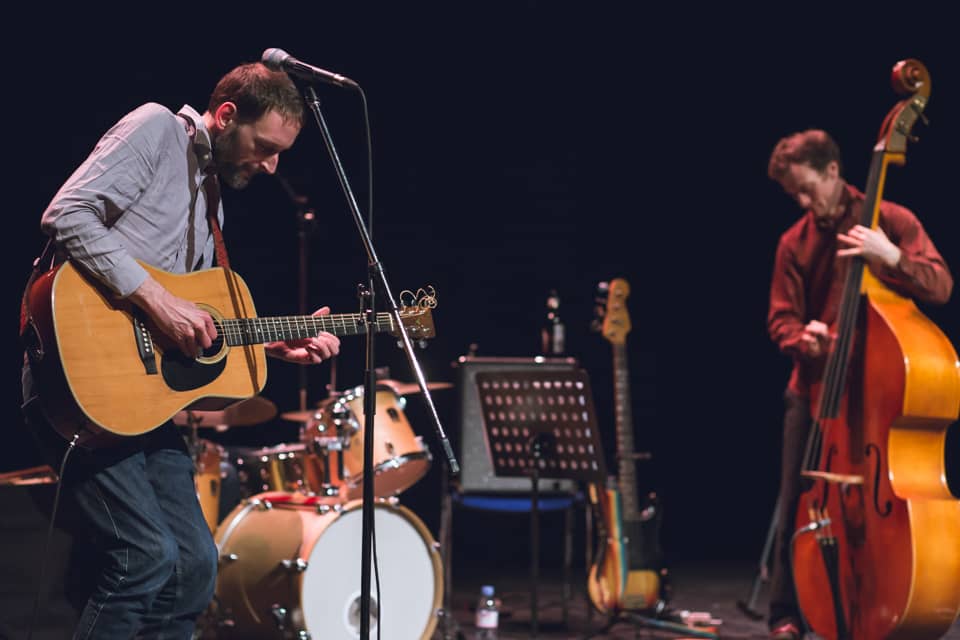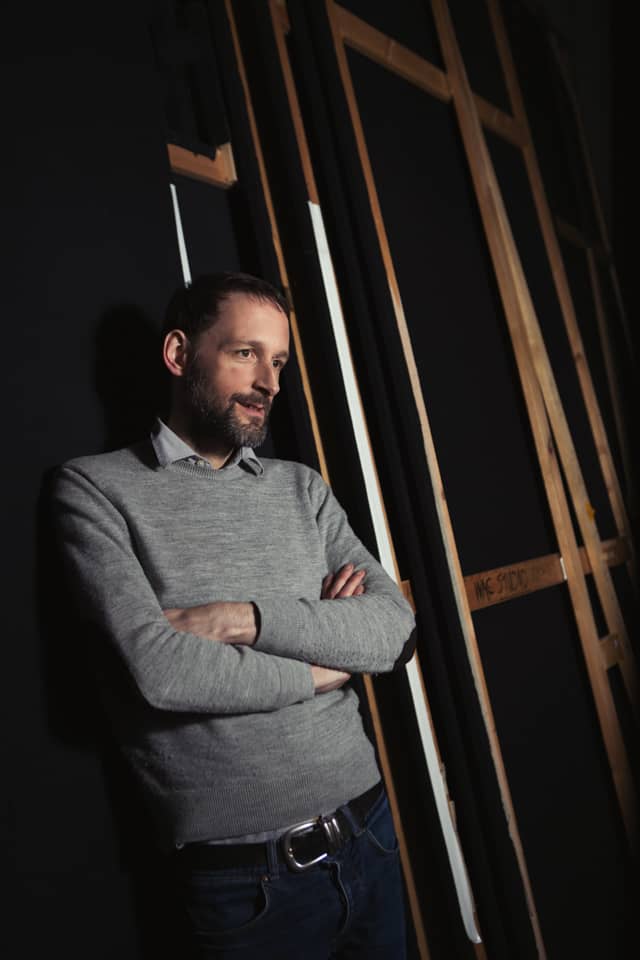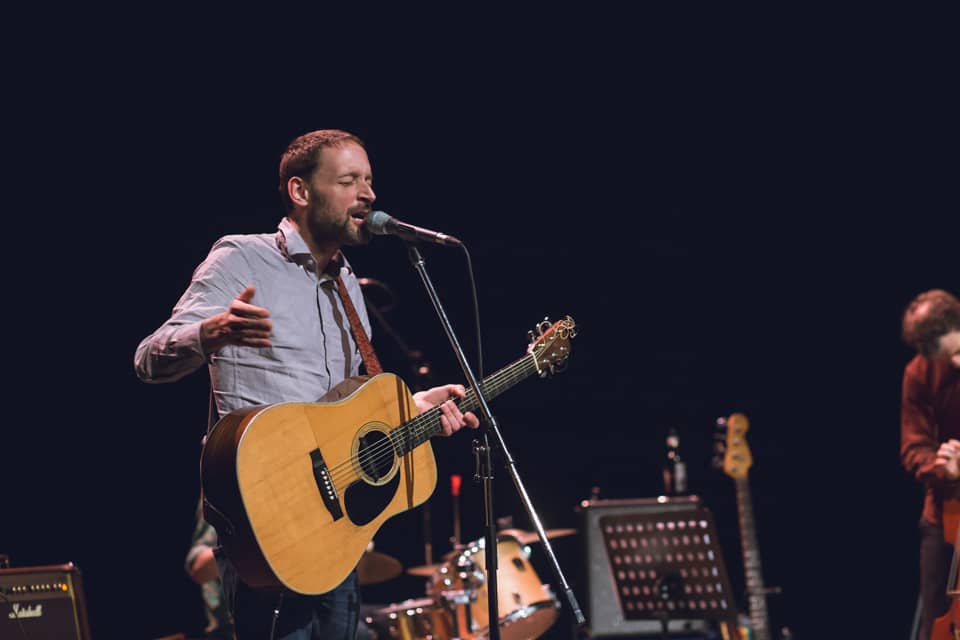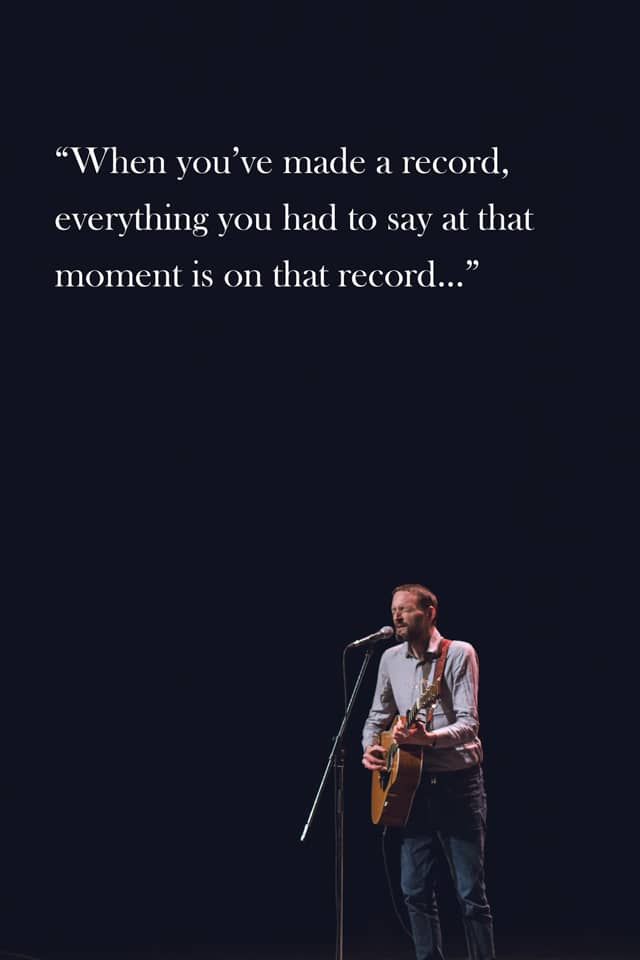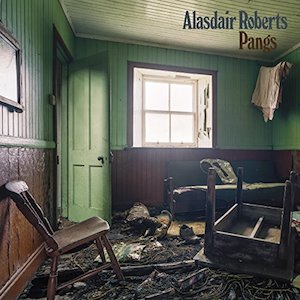“It’s funny” reflects Alasdair Roberts as he leans on the green room counter, “I think some people regard me as primarily a traditional singer whereas other people probably regard me as more of a songwriter…speaking of those who regard me at all, which is few!”
It’s clearly a modest observation. The truth is that lots of people ‘regard’ Alasdair Roberts and highly at that. Over twenty years of prolific recorded output and live performances have left their mark; he’s widely regarded as one of Scotland’s finest current songwriters. A key factor in Roberts’ artistic credibility is a continual and uncompromising drive to find fresh ways to present original and traditional music. His latest release ‘Pangs’ continues the journey; acoustic and electronic sounds interweave to underpin a diverse collection of Roberts’ self-penned songs. FRUK’s Thomas Blake summarised it as a ‘cracking instalment from one of the finest recording artists currently working in the folk idiom’ (read the full review here).
When I catch up with Alasdair, he’s in the middle of a March tour alongside Stevie Jones and Alex Neilson to promote Pangs. So far things have been going well;
“This new record and the tour so far, considered as a whole experience, has been a good one” he concludes. “It’s felt more serious and mature than before. I think it’s been one of the most satisfying UK tours that I’ve done really. The turnouts have been good, people have been nice, sales of merchandise have been steady.”
His feelings about the album now that it’s ‘out in the wild’ are equally positive; “I’m pleased with it. It’s had some nice reviews. A lot of work and care and thought went into the production of it at every stage, a lot of emotional energy. It’s nice because that seems to have been recognised.”
Pangs was principally recorded by Alasdair, Stevie and Alex over the course of a week at the Analogue Catalogue studio in County Down where engineer Julie McLarnon brought her years of experience working in analogue to bear on Roberts’ creations. After a ferry journey back to Alasdair’s home city of Glasgow, the record was finished with contributions from Tom Crossley on flute, Rafe Fitzpatrick on fiddle, Jessica Kerr on cello and Debbie Armour on vocals.
For Alasdair, working in analogue was a key feature of this album;
“The sound quality is probably irreplicable” he asserts. “There are people who will argue that you can replicate or near replicate that kind of sound or feel in the digital domain…I don’t really agree. It also changes the approach. With digital, you can have an infinite amount of space and as many tracks as you want in all directions, whereas analogue has got these limitations. You’ve got to be more decisive I think. The album was mostly done live, so you’ve got to try and nail it in that live take which I enjoy. It’s more challenging. You have to be harder on yourself to try and elicit a strong performance; you can’t just be like ‘oh fuck this, we’ll fix it later.’ You can’t think like that…”
Striving to create something fresh with every recording is a preoccupation in Alasdair’s work. “I don’t see it in terms of being a linear progression” he reflects. “Maybe there is some kind of arc, but I tend to think of each individual record on one level as an attempt to do something different from what came before it. One of the aims in making something is to try and do something new. I’m satisfied if that happens.”
Alasdair’s constant search to create something new is juxtaposed with the foundation of traditional music that underpins much of his work. It’s a reference point that he traces back to his earliest musical influences;
“I grew up in a village called Killmahog which is just outside Callander. It was a really small place; there wasn’t a lot going on culturally there. I didn’t really grow up in a traditional music community, although my father Alan had been a folk musician in the 60’s in Glasgow and then in the 70’s in Germany. Him and my mother Peggy used to run a booking agency in Germany. Some of the earliest music I would have heard would have been that classic era of 70’s Scottish folk…bands like Silly Wizard, Tanahill Weavers…bands like this who they booked. That left an impression from my infancy, but I grew up listening to pop music on the radio and later on to John Peel, discovering more alternative, non-standard music. When I moved to Glasgow, it was more on the underground DIY scene that I was most active.”
He continues; “Later, probably in my early twenties, I gradually became more interested in traditional music. I started exploring and feeling like I could take part in that. Maybe I didn’t really feel before then that I could have any claim to anything from that because I was estranged from it and hadn’t grown up with it. My father taught me a few songs. He used to play in the house, and we’d play together quite a lot. A couple of the first traditional songs I learned were from him. I think that’s when I got more deeply into it when I started to take it more seriously as a research area.”
This interest led to a number of albums dedicated to traditional music, the most recent being ‘Too Long In This Condition’ in 2010. Alasdair’s work since then has been focused more on his own songwriting. However, his understanding of traditional music is evident even in his own creations;
“At the moment I’m more interested in songwriting, but I feel the older, traditional songs and the ballads are always with me. They travel with me and I can tap into them. Nowadays most of the concerts I do, there’ll only maybe be at most three or four traditional songs, but I could conceivably do an entirely traditional based performance, or I could do entirely self-written. Melodically, and also lyrically, my work draws often on traditional material…it’s an influence that I do tend to return to.”
Alasdair goes on to describe how traditional tunes can form the starting point for his own writing;
“You don’t want things to become formulaic, but I probably do have tendencies in terms of the way I work. Quite often, melodically for a song of my own I’ll extrapolate something from a traditional tune or something like that. They could be tunes that I hear in sessions, that I learn from friends or I hear in archive recordings…that will be a starting point for my own tune, which could deviate quite a lot from the original tune, or it might be quite close to it. I think that indicates that I’m something of a formalist in a way, a ‘structuralist’. I like to have that bedrock to things and then build up from that.”
The creative process is somewhat of an obsession for Alasdair, which probably accounts in part for his prolific output in recorded work. It can, however, also result in some discomfort when for whatever reason, the creative process isn’t working;
“I go through periods of not really creating, not really writing” he explains, “I think since making the Pangs record I’ve only written two, maybe three, new songs. But I’m in the middle of this touring cycle where you don’t really have time for that sort of creative work, so I just have to be patient and know that at some point I will have the time…maybe to even go away somewhere and think for these few days I’m just going to sit and write.”
He returns to the subject of needing to always be creating something new;
“It’s also knowing what you have to say. When you’ve made a record, everything you had to say at that moment is on that record. I always feel that you need to metamorphose into a different person, with a different set of interests, preoccupations and concerns in order to write something genuinely new. Otherwise, if you’re just writing about the same concerns you’re just going to write the same stuff. Having said that, there are probably key concerns that run through the work but they’re elemental human concerns which affect everyone. It’s about finding an individual approach to those universal concerns.”
For now, Alasdair has plenty to keep him occupied; “I’ve been doing some recordings with a friend called David McGuinness who’s a pianist. A couple of years ago now, Neil McDermott recorded us performing a collection of eight traditional ballads together, piano and voice. An electronic musician called Amble Skuse has contributed some electronics to some of the tracks. We’re hoping to finish that within the next few months. That might be the next record, I’m not totally sure yet. I’m still writing and I’m doing quite a few things this summer with The Furrow Collective. Quite a few things on the go….”
Drag City – 2017


